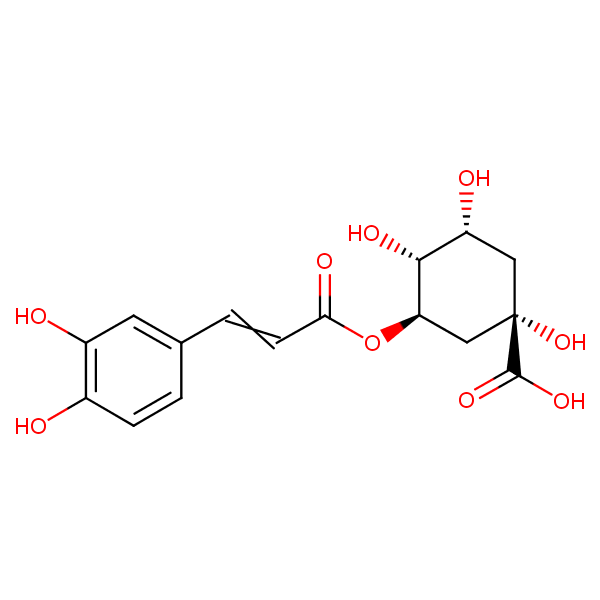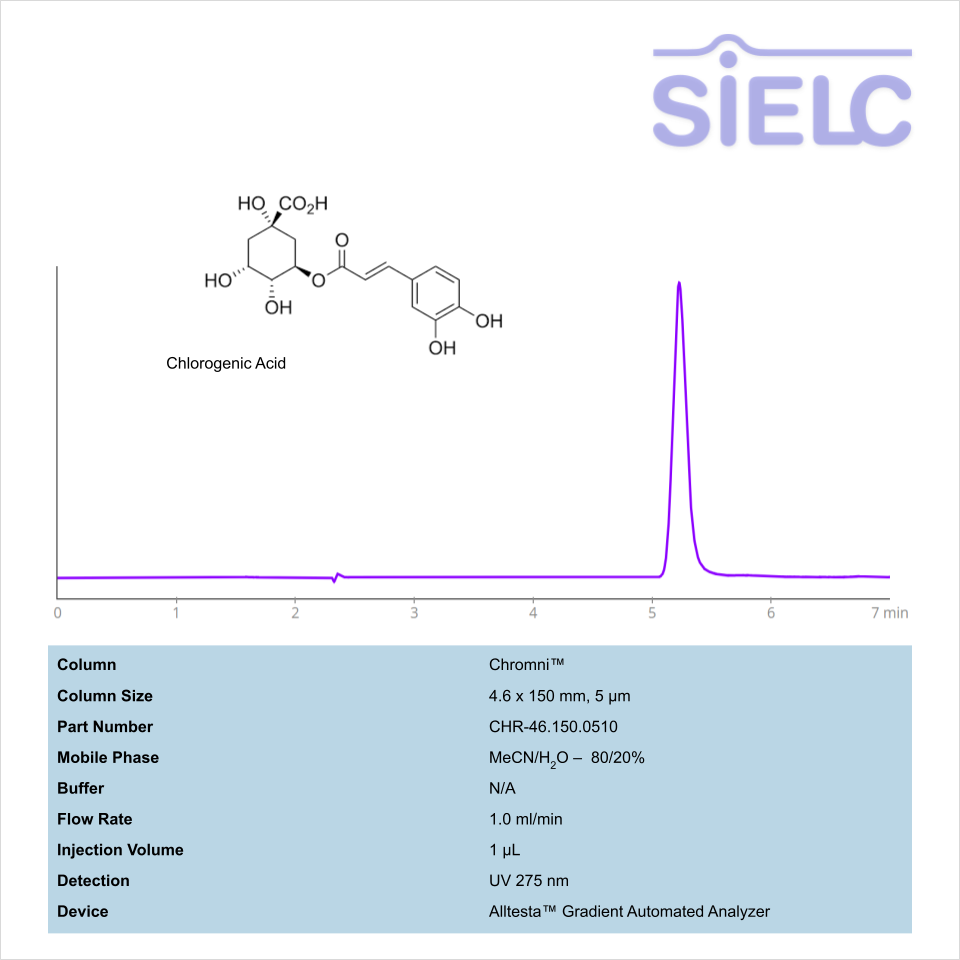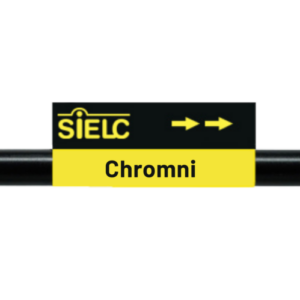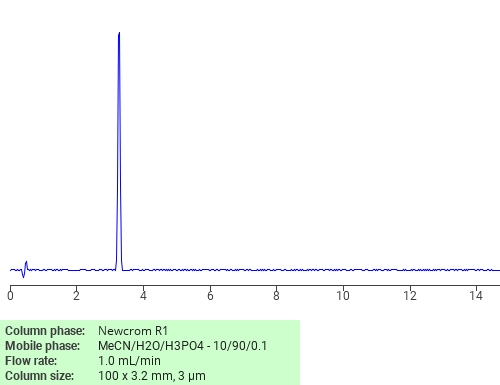| CAS Number | 327-97-9 |
|---|---|
| Molecular Formula | C16H18O9 |
| Molecular Weight | 354.312 |
| InChI Key | CWVRJTMFETXNAD-NCZKRNLISA-N |
| LogP | -0.284 |
| Synonyms |
|
Applications:
HPLC Method for Analysis of Chlorogenic Acid on Chromni™ Column on Alltesta™
December 1, 2025
HPLC Method for Chlorogenic acid on Chromni™ by SIELC Technologies
High Performance Liquid Chromatography (HPLC) Method for Analysis of Chlorogenic acid
Chlorogenic acid is a natural compound that belongs to the polyphenol family, which is abundant in various plants. It is particularly prevalent in coffee beans, fruits, vegetables, and whole grains. One of its primary dietary sources is coffee, where it is found in significant amounts. It is well known for it’s antioxidant properties, which means it can help neutralize free radicals in the body. Free radicals are molecules that can damage cells and contribute to aging and various diseases. Evidence suggests that chlorogenic acid may have a positive impact on blood sugar levels. It may help regulate glucose metabolism, making it of interest in managing diabetes and insulin resistance. You can find detailed UV spectra of Chlorogenic acid and information about its various lambda maxima by visiting the following link.
Chlorogenic acid can be retained and analyzed using the Chromni™ stationary phase column. The analysis utilizes an isocratic method with a simple mobile phase consisting of water and acetonitrile (MeCN) with phosphoric acid as a buffer. Detection is performed using UV.
| Column | Chromni™, 4.6 x 150 mm, 5 µm, 100 A, dual ended |
| Mobile Phase | MeCN – 80% |
| Buffer | Ammonium Formate |
| Flow Rate | 1.0 mL/min |
| Detection | UV 275 nm |
| Class of Compounds | Acid |
| Analyzing Compounds | Chlorogenic acid |
Application Column
Chromni™
Column Diameter: 4.6 mm
Column Length: 150 mm
Particle Size: 5 µm
Pore Size: 100 A
Column options: dual ended

UV-Vis Spectrum of Chlorogenic Acid
July 15, 2024
Access the UV-Vis Spectrum SIELC Library
If you are looking for optimized HPLC method to analyze Chlorogenic acid check our HPLC Applications library
For optimal results in HPLC analysis, it is recommended to measure absorbance at a wavelength that matches the absorption maximum of the compound(s) being analyzed. The UV spectrum shown can assist in selecting an appropriate wavelength for your analysis. Please note that certain mobile phases and buffers may block wavelengths below 230 nm, rendering absorbance measurement at these wavelengths ineffective. If detection below 230 nm is required, it is recommended to use acetonitrile and water as low UV-transparent mobile phases, with phosphoric acid and its salts, sulfuric acid, and TFA as buffers.

HPLC Method for Analysis of Chlorogenic Acid on Newcrom BH Column
March 8, 2024
HPLC Method for Analysis of Chlorogenic acid on Newcrom BH Column by SIELC Technologies
Separation type: Liquid Chromatography Reversed-phase
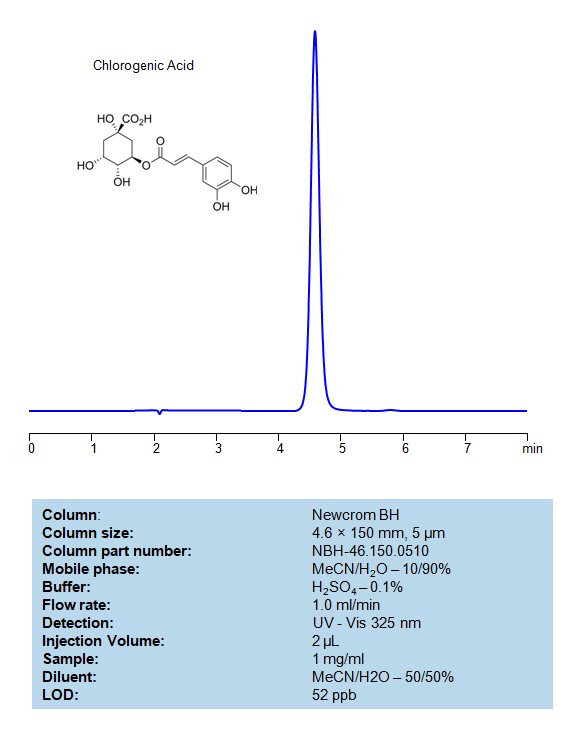
Chlorogenic acid is a natural compound that belongs to the polyphenol family, which is abundant in various plants. It is particularly prevalent in coffee beans, fruits, vegetables, and whole grains. One of its primary dietary sources is coffee, where it is found in significant amounts.
Key points about chlorogenic acid include:
Antioxidant Properties: Chlorogenic acid is known for its antioxidant properties, which means it can help neutralize free radicals in the body. Free radicals are molecules that can damage cells and contribute to aging and various diseases.
Potential Health Benefits: Research suggests that chlorogenic acid may have several potential health benefits, including improving heart health by reducing blood pressure and improving blood vessel function. It may also have anti-inflammatory effects.
Weight Loss: Chlorogenic acid has been studied for its potential role in weight loss. Some research indicates that it may help reduce body weight by influencing metabolism and fat absorption.
Blood Sugar Regulation: There is evidence to suggest that chlorogenic acid may have a positive impact on blood sugar levels. It may help regulate glucose metabolism, making it of interest in managing diabetes and insulin resistance.
Sources: Besides coffee, chlorogenic acid is found in fruits like apples, pears, and berries, as well as in vegetables like tomatoes and artichokes. It’s also present in some whole grains.
Chlorogenic Acid can be retained and analyzed on a reversed-phase Newcrom BH column with a mobile phase consisting of water, Acetonitrile (MeCN), and sulfuric acid. This analytical method can be detected with high resolution and peak symmetry at a wavelength of 220 nm using UV detection
High Performance Liquid Chromatography (HPLC) Method for Analyses of Chlorogenic acid on Newcrom BH Column by SIELC Technologies
Condition
| Column | Newcrom BH, 4.6 x 150 mm, 5 µm, 100 A, dual ended |
| Mobile Phase | MeCN/H2O – 10/90% |
| Buffer | H2SO4 – 0.1% |
| Flow Rate | 1.0 ml/min |
| Detection | UV Vis 325 nm |
| Injection volume: | 2 µL |
| Sample | 1 mg/ml |
| Sample Diluent | MeCN/H2O – 50/50% |
Description
| Class of Compounds | Acid |
| Analyzing Compounds | Chlorogenic acid |
Application Column
Newcrom BH
Column Diameter: 4.6 mm
Column Length: 150 mm
Particle Size: 5 µm
Pore Size: 100 A
Column options: dual ended

Separation of Chlorogenic acid on Newcrom R1 HPLC column
February 16, 2018
Chlorogenic acid can be analyzed by this reverse phase (RP) HPLC method with simple conditions. The mobile phase contains an acetonitrile (MeCN), water, and phosphoric acid. For Mass-Spec (MS) compatible applications the phosphoric acid needs to be replaced with formic acid. Smaller 3 µm particles columns available for fast UPLC applications. This liquid chromatography method is scalable and can be used for isolation impurities in preparative separation. It also suitable for pharmacokinetics.
Application Column
Newcrom R1
The Newcrom columns are a family of reverse-phase-based columns. Newcrom A, AH, B, and BH are all mixed-mode columns with either positive or negative ion-pairing groups attached to either short (25 Å) or long (100 Å) ligand chains. Newcrom R1 is a special reverse-phase column with low silanol activity.
Select options